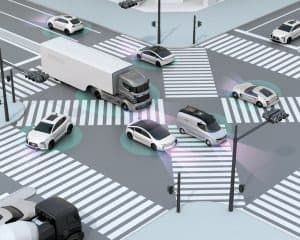
With predictive intelligence, in-vehicle applications will know about upcoming coverage gaps or connectivity issues before they happen, and be able to take proactive action to mitigate them.
Few tech trends have captured the imagination like connected cars. From self-driving vehicles to automotive app ecosystems to Smart City traffic applications, the next few decades promise to reshape the driving experience—and potentially, transportation itself. But, while most of the buzz focuses on automotive applications that sound like they came out of Star Trek, we should remember that they all depend on one thing: a consistent, high-performing wireless connectivity.
The more “mission-critical” the application, the more important that connectivity becomes. If you hit a dead spot on the highway while your kids are streaming a movie, you might have to deal with a few minutes of whining. But what happens when your autonomous vehicle’s GPS maps fail to update? What if the results displayed in your Smart City parking app are two minutes behind real time? What if your car’s intersection assistant, which anticipates real-time collision hazards, is lagging 10 seconds behind?
See also: GlobalData: Autonomous Vehicles Will Dominate Deliveries
For these scenarios and many others, the consequences of poor connectivity can be dire. Wouldn’t it be helpful to have some insight into the kind of connection you can expect a few minutes or miles down the road? Given the consequences of unexpected connectivity loss, you could make the case that the most exciting connected car applications absolutely require that kind of predictive foresight.
Fortunately, this type of automotive ESP is no longer science fiction. Emerging “connectivity assurance” technologies can give stakeholders across the connected car ecosystem (network operators, automotive manufacturers, app developers and others) the ability to predict and proactively optimize for fluctuating wireless connectivity. These capabilities may not get as much press as self-driving cars, but they’ll play a big role in the future of connected vehicles.
Predicting Vehicle Connectivity
To fulfill the promise of connected car experiences in real-world driving scenarios, application providers need the ability to monitor radio system performance and track application quality of experience in real time. Specifically, they need the ability to understand how a connected vehicle’s throughput and latency will fluctuate over the course of a trip, and to predict upcoming coverage and data performance gaps so they can avoid or optimize around them. Managing and predicting connectivity, however, is not a simple problem. It entails monitoring multiple real-time services, including the performance of the in-vehicle radio system (which is different from a driver’s smartphone, even within the same car), the app’s quality of experience, and the performance of the cellular connection.
Tomorrow’s connected vehicles will use embedded software clients in their telematics control units (TCUs) to communicate back to cloud services, providing continuous details about throughput, latency and availability. These clients will passively monitor radio parameters and network signaling, so they don’t consume wireless bandwidth. They will then upload the data to a cloud database, where it can be used to create detailed geodata maps of cellular performance.
Mobile network operators (MNOs), as well as their Automotive OEM and connected car application provider customers, will use these maps to make granular predictions about the availability and performance of each car’s connection, based on a GPS destination or just the direction the vehicle is moving. With this predictive intelligence, in-vehicle applications will know about upcoming coverage gaps or connectivity issues before they happen, and be able to take proactive action to mitigate them.
Proactive actions could entail, for example, a streaming video app increasing buffering to assure a seamless experience through an area of patchy coverage. A self-driving car’s navigation system could know ahead of time when it needs to pre-download maps. An advanced driver-assistance system (ADAS) like hands-free cruise control could increase the distance it maintains between vehicles to account for higher latencies. For some applications, proactive action could just mean alerting drivers to expect connectivity problems, so they can, for example, hold off on making an important call or choose an alternate route that won’t disrupt their kids’ online gaming.
An Emerging Ecosystem
Those are just a few examples of the possibilities for these kinds of predictive insights. At this early stage in the game, we don’t yet know how these opportunities will translate into concrete services and business models. But it’s easy to see how everyone involved in emerging connected car ecosystems can take advantage of them.
Automotive original equipment manufacturers (OEMs) and app providers are very interested in predictive connectivity. For OEMs, the thin client monitoring on TCU’s and resulting connectivity assurance solutions allow them to maintain consistent quality for connected vehicle services and safety features. Additionally, the monitoring data can be leveraged to proactively identify in vehicle problems leading to reduced warranty issues. Lastly as they work to test and certify new connected apps and services, the predictive coverage dataset becomes an important input to simulation testing models so they can test and optimize for issues associated with fluctuating performance. These same capabilities will also be valuable to third-party connected car and Smart City app providers.
Looking Ahead
In the coming years, connected vehicles will reshape transportation and open up a new world of business models, driving experiences and productivity. Emerging connectivity assurance solutions that allow stakeholders to monitor vehicle connectivity performance and predict coverage gaps will play a big role in making it happen well. Of course, connected car ecosystems are just beginning to emerge, and the decisions that stakeholders make today will help shape the future of these types of predictive services.
As they survey the options for monitoring in-vehicle connectivity, MNOs and automotive OEMs should make sure they’re working with vendors who can provide an independent, unbiased reference for evaluating network and service quality. They should also look to create collaborative ecosystems to help move the needle across all parties tied to the connected car story. Without collaboration, silos occur and create greater complexity when handing off connectivity and wireless coverage. Finally, choose partners with deep experience in wireless coverage testing.
It’s too early to say exactly how the ecosystem for predictive connectivity assurance will shake out. But there’s one thing we can say with confidence: The road to the future of driving is right in front of us. It should be an exciting journey.






























